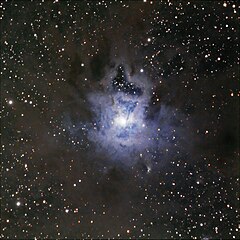Mgławica Irys
 Mgławica Irys (Hunter Wilson) | |
| Odkrywca | |
|---|---|
| Data odkrycia | 18 października 1794 |
| Dane obserwacyjne (J2000) | |
| Gwiazdozbiór | |
| Typ | |
| Rektascensja | 21h 01m 35,6s |
| Deklinacja | +68° 10′ 10″ |
| Odległość | 1400 ly |
| Jasność pozorna mgławicy | 6,8m |
| Rozmiary kątowe | 18' × 18' |
| Charakterystyka fizyczna | |
| Wymiary | 6 ly |
| Alternatywne oznaczenia | |
| NGC 7023, OCL 235, LBN 487, Caldwell 4 | |
Mgławica Irys (również NGC 7023) – mgławica refleksyjna znajdująca się w konstelacji Cefeusza. Została odkryta 18 października 1794 roku przez Williama Herschela[1]. Mgławica ta jest położona około 1400 lat świetlnych od Ziemi.

Mgławica Irys znajduje się na północnym końcu ogromnego, lecz niewidzialnego optycznie obłoku molekularnego. Jest oświetlana przez jasną gwiazdę SAO 19158, przesłoniętą gęstymi zasłaniającymi obłokami pyłu. Niebieskie światło gwiazdy odbija się od powierzchni drobnych cząstek pyłu. Mgławica Irys emituje również promieniowanie, głównie podczerwone, pochodzące od mikroskopijnych cząstek pyłu mgławicy.
Zobacz też
Przypisy
Bibliografia
- Robert Gendler Niebo, Rok wydania: 2007, Wydawnictwo: Carta Blanca, ISBN 978-83-60887-00-4.
Linki zewnętrzne
- Mgławica Irys w serwisie APOD: Astronomiczne zdjęcie dnia
- Mgławica Irys w serwisie SEDS.org (Revised NGC and IC Catalog) (ang.)
- Mgławica Irys w bazie SIMBAD (ang.)
Media użyte na tej stronie
Autor: NASA Hubble, Licencja: CC BY 2.0
This beautiful, blushing nebula is unique amongst its counterparts. While many of the nebulas visible in the night sky are emission nebulas — clouds of dust and gas that are hot enough to emit their own radiation and light — Caldwell 4, otherwise known as the Iris Nebula or NGC 7023, is a reflection nebula. This means that its color comes from the scattered light of its central star, which lies nestled in the abundant star fields of the constellation Cepheus. Located some 1,400 light-years away from Earth, the Iris Nebula’s glowing gaseous petals stretch roughly 6 light-years across.
The Iris Nebula was discovered by German-British astronomer Sir William Herschel on October 18, 1794. (Herschel has an impressive track record, having also discovered the planet Uranus and having been knighted in 1816.) His Iris Nebula has an apparent magnitude of 7. Located near the North Celestial Pole and the North Star (Polaris), Caldwell 4 is nearly impossible to see from the Southern Hemisphere. For best viewing in the Northern Hemisphere, use a telescope in early autumn to star hop from the two brightest stars in the constellation Cepheus. Since the Iris Nebula is faint and diffuse, dark skies away from city lights are recommended for viewing it.
This nebula is of particular interest to scientists because of its colors. Reflection nebulas glow because they are made up of extremely tiny particles of solid matter, up to 10 or even 100 times smaller than dust particles on Earth. These particles diffuse the light around them, giving the nebula a second-hand glow that’s typically bluish (like our sky). While the Iris Nebula appears predominantly blue, it includes large filaments of deep red, indicating the presence of an unknown chemical compound likely based on hydrocarbons. Studying nebulas like this one helps astronomers learn more about the ingredients that combine to make stars.
This close-up image, showing one rosy-colored region within Caldwell 4, is a composite of four exposures captured by Hubble’s Advanced Camera for Surveys in visible and near-infrared filters. Astronomers also studied the nebula with Hubble’s Near Infrared Camera and Multi-Object Spectrometer (NICMOS) to try to determine which chemical elements are present in Caldwell 4.
Credit: NASA & ESA
For more information, see:
www.spacetelescope.org/news/heic0915/
For Hubble's Caldwell catalog site and information on how to find these objects in the night sky, visit:
www.nasa.gov/content/goddard/hubble-s-caldwell-catalogAutor: Hewholooks, Licencja: CC BY-SA 3.0
Iris Nebula LBN 487 and NGC 7023 in Cepheus

